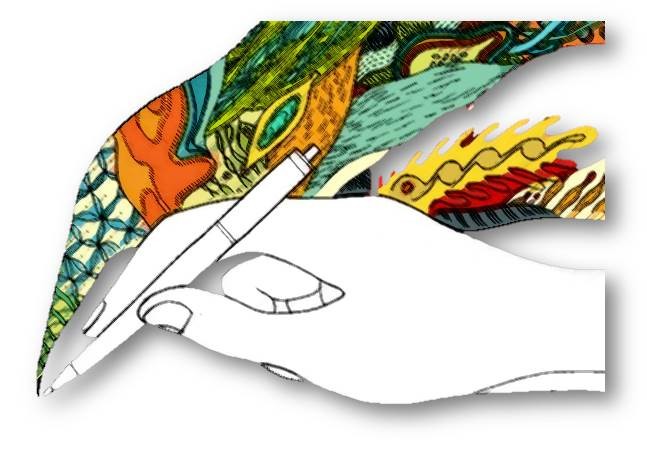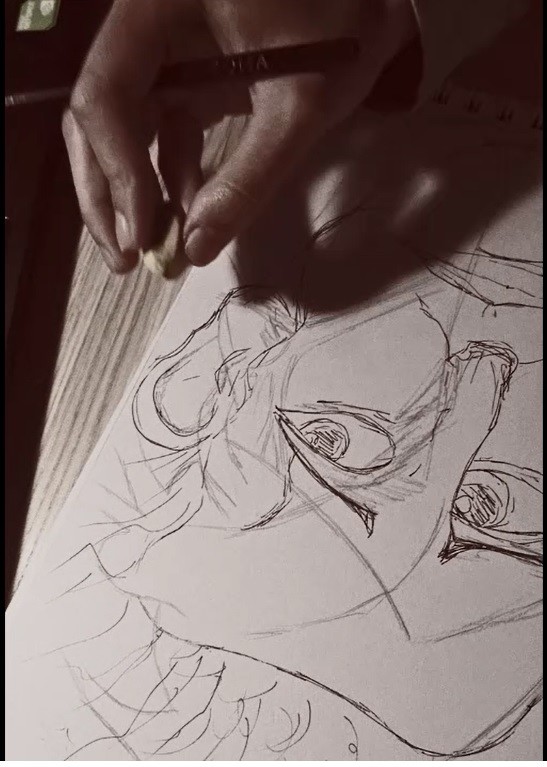Paperwork about... an Italian
For the Italian Literature course, I wrote the final paper, an essay about Giacomo Leopardi's work of art, art in words.
My paperwork included as well a presentation, some images, and comments made by myself where I was trying to have a critical eye (more or less). But the interesting part, the main idea where I was building on, was the portrait of the author based on his feeling, emotions, metaphors, and key-words that his poem has integrated into. So the project was about written art and visual art.

- The first part includes the text analysis, also the author's one, and the poetic idea. I chose to translate also in my language to show the difference between the original and the two languages in which I can understand the poem; the finest line of metaphors is way changed by the different language expression and that's an assumed risk.
Introduction
From the very beginning, the Greeks named the act of creation and creation itself “poitis”, poetry.
In time, through his motifs and symbols, his creation took different forms of literary expression.
Poetry is the result of the mixture and concretization of feelings, of mastering the inner tension of the narrator and can be considered a fight of the genius with itself.
Between the “beautiful and the truth”, the symbol of the creative genius becomes a thin line between the motifs in Leopardi’s conception of the world and his own life.
Leopardi and the poetic inspiration
Leopardi’s creation is the exposition of a troubled meditation of the narrator, a lack of fulfillment in life which leads to an elaborate and complex pain to an astronomic level. L’infinito, therefore, shows the loss of self in the enigmatic universe.
In connection with the motifs of the work that follows the image of the Infinite, the title holds respect to the keyword, through the reality of what constitutes the motif of the narrator’s confession to the symbolical plan designating the unbreakable bond between undefined expression and the experience of the vague.
The experience of the infinity is the product of the contrast between the two opposing plans for the creation, the semantical plan, and the temporal plan.
Structural analysis of the poem
The work of Leopardi is structured in fifteen verses interrupted by “enjambaments” thus annulling the pause in the rhythm of the poem. This stylistic effect is present in both translations of the poem with the difference being the permanent introduction of the verse in capital letters in the English version of the poem, this could be, perhaps, the elimination of the poetic flow or emphasizing the poetic idea with respect to the metaphor of infinity.
The narrator focuses the poetic discourse in four frames, four steps that outline four different poetic moods. The uniqueness of the frame being comprised of the willed interruption of the discourse both in the middle of the verse and at its end, creating a stop in the flow due to the importance of the message creating ambiguity as a poetical effect.
The absence of rhyme emphasizes the meaning of the verse, creating a sensibility within the reader, creating an opening in the words with an undefined horizon of imagination, although, the absence of rhymes does not affect in any way the rhythm of the poem, it creates a more alert pace in the reading.
The symmetry of the verse in a measure of 11-12 syllables per verse, forms an equilibrium in the narrators' expression of emotions, the framing of the four moods of the narrator into inner meditation creating to the suspense made possible by the “enjambaments”. In other words, the attraction of the reader to step into the profound meditation is maintained by the “enjambement” effect present with regularity within the verses.
Elements that give a musical tone to the poem, project the words through abstract images and deep hearing effects with the stylistic sounds and visuals lined together with the verbs that manage to form a visual art of an inner voice.
The alternation between alliterative and assonantal “Ma sedendo e mirando, interminati” and “Cosi tra questa/immensita s’annega il pensier mio” or in English “the infinite silence and that passing voice” and in Romanian “tăceri supraomenești, cea mai adâncă pace” creates the sounds of the expression. The comparison between the ‘voice’ of the wind along with the infinite quiet outlines the reaction of the narrator on eternity and the remembrance of time “E come il vento/ odo stromir tra queste piante, io quello/ infinity silenzio a questa voce/ comparando”. Leopardi’s poem embraces intense allegory on the superhuman quiet. in figurative speech, and the eternal silence, the inner peace of the narrator in literary speech. The antithesis between “infinito silenzio”, “questa voce”, “le morte stagioni” and “la presente, e viva” the terms highlighting each other in the interior of the same narrative frame.
The part of the living that provokes vibrations in a semantical level is sketched by the use of verbs. The poem uses verbs in three forms: the infinitive, the gerund and the present tenses which lead the dynamic of the message of the narrator towards the key to understanding the symbol of the universal creative genius. Verbs such as: “esculde”, “fingo”, “spaura”, “odo/stromir”, “sovvien”, “s’annega” and “m’e” are used for the expression of the idea of an eternal nature depicted, elements that compose the frame of the infinite. The dynamic content, however, is shown through the verbs “sedendo”, “mirando”, “comparando” having the capacity of creating dynamic images to depict the ambiguity of the poem in a stylistic manner.
The motif of the poem
This complex creation is the product of a meditation on the human spiritual condition, the narrator making his appearance between the limit of the monologue and the intense vibrations of the quiet.
The space creates the two narrative frames: “questa’, almost visible and “quello” the infinity which the narrator rejects and we cannot physically interact with it, and we can only imagine it.
As a result of the allegory and the “road” paved with symbols, the narrator finds himself in a tragic moment of existence, feeling how the essence of his existence, thoughts drown in a borderless image which mirrors the infinite “tra questa/ immensita s’annega il pensier mio/ e naufragar m’e dolce in questo mare”.
A comparison between Leopardi and Romanian poets
Mihai Eminescu
In comparison to the poems by Mihai Eminescu, we can reveal the same theme of lyrical creation: romanticism, expressing the motif of the creator genius opposing the common man, the same philosophical idea taken from Schopenhauer.
“Glossa” is a poem which revolves around the condition of the genius, which, due to the superiority concept the narrator is forced to withdraw from the narrow world of the common. Also, it is a poem of ideas, a philosophical creation, the product of a hard work (every verse ending with a conclusion). In “Glossa” time takes the place of Leopardi’s wind “Days go past and days come still/ What is well and what is ill” are a meditation on the theme of time opposing time as a universal concept. The words “days” and “all” suggests the static part of existence, the part which the genius must emphasize.
"Days go past and days come still
All is old and all is new,
What is well and what is ill,
You imagine and construe;
Do not hope and do not fear,
Waves that leap like waves must fall;
Should they praise or should they jeer,
Look but coldly on it all".
- and the Romanian -
“Vreme trece, vreme vine
Toate-s vechi și nouă toate
Ce e rău și ce e bine
Tu te-ntreabă și socoate
Nu spera și nu ai teamă
Ce e val, ca valul trece
De te-ndeamnă, de te cheamă
Tu rămâi la toate rece.”
-
First stanza in “Glossa”
George Bacovia
Stylistically different and with a different transmission of his vision, Bacovia, a symbolist affirmed through the gathering of suggestion and synesthesia, the Bacovian universe being the sober and dismal constructed through free verse.
Through his works, he cultivates themes such as the condition of the poet, poetry, nature, love, anxiety, the city, death, evasion, claustration, and motifs of loneliness and melancholy.
“Epitaph” reflect on the condition of the lonely creative genius in the fight, in meditation and in the contemplation of the self.
“Here I am
A solitary,
That laughed bitterly
And always cried.
With my aspect
Made me die
For everyone,
I was suspect.”
- the Romanian -
"Aici sunt eu
Un solitar,
Ce-a râs amar
Si-a plâns mereu.
Cu-al meu aspect
Făcea să mor
Căci tuturor
Păream suspect."
Okay, so this was the paperwork. Now, for the presentation, things worked a bit different. Why? - because the images were spoken more than my words.

- this is my drawing that turns from a heart, his heart, to an image of his face
Then, the last thing I wanted to mention about, and I added it only in my presentation was about an article found random on the internet, about a commemorative plaque:

Starting with 14th of June 2003, the great Italian poet Giacomo Leopardi’s hometown, Recanati, hosts the effigy of the Romanian poet Mihai Eminescu.
the English for this will sound like:
"The God of Genius has taken me from the people as the sun sipped a golden cloud from the sea of bitterness."
Photo gallery
Want to have your own Erasmus blog?
If you are experiencing living abroad, you're an avid traveller or want to promote the city where you live... create your own blog and share your adventures!
I want to create my Erasmus blog! →



















Comments (1 comments)
Dear Miss. Brandy Bungărdean
you did an extraordinary job with the life, the artistic views and poetry of Giacomo Leopardi. I'm not an expert like a Doctor in Literature, but I really loved and enjoyed your comment and analysis; I'm an art lover. Leopardi, it was a very deep, intense and sensitive Italian author and I'm quite sure you've perfectly understood his way to live, feel, his artistic point of view and life. I adored your drawings and paintings, and I also adored the comparison with the Romanian Author. It's very meaningful and positive when different cultures meet up creating this balanced mixture.
Best.
Nicolò